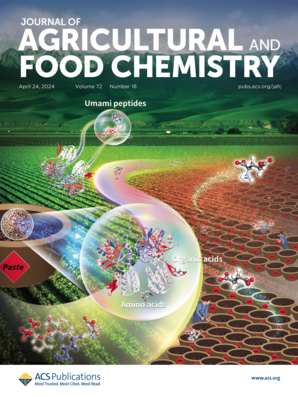PI3K-Mediated Regulation of Glycogen Metabolism To Facilitate Tomato chlorosis Virus Transmission by Bemisia tabaci MED.
IF 6.2
1区 农林科学
Q1 AGRICULTURE, MULTIDISCIPLINARY
引用次数: 0
Abstract
Tomato chlorosis virus (ToCV), transmitted by whiteflies (Bemisia tabaci), threatens global tomato production. However, the molecular mechanisms underlying the ToCV transmission by whiteflies remain largely unknown. Previous studies have shown that several key regulators of glycometabolism, downstream of the phosphoinositide 3-kinase (PI3K) pathway, are significantly increased in B. tabaci MED infected with ToCV. We demonstrate that ToCV activates PI3K in whiteflies, as evidenced by upregulated PI3K gene expression and increased PI3K enzyme activity. RNA interference-mediated knockdown of PI3K significantly reduced ToCV acquisition, retention, and transmission. Similarly, feeding whiteflies with the PI3K inhibitor PI3K-IN-1 decreased ToCV transmission, while the PI3K activator Recilisib enhanced it. Further analysis showed that the activation of PI3K enhances glycogen synthesis by upregulating genes related to glycogen synthesis, including serine/threonine kinase (AKT), glycogen synthase (GS), and glycogenin (Gly), and thus leads to an increase in glycogen content while reducing glucose levels. Conversely, the inhibition of PI3K disrupts glycogen metabolism, consequently impairing viral transmission. These findings highlight that PI3K is crucial for facilitating ToCV transmission by whiteflies and offer a potential target for controlling vector-borne plant viruses.pi3k介导的糖原代谢调控促进烟草粉虱MED传播番茄萎黄病毒
由白蝇(烟粉虱)传播的番茄褪绿病毒(ToCV)威胁着全球番茄生产。然而,白蛉传播ToCV的分子机制仍然是未知的。先前的研究表明,在感染ToCV的烟叶杆菌中,糖代谢的几个关键调节因子,磷酸肌肽3激酶(PI3K)途径下游,显著增加。我们证明ToCV激活了白蝇的PI3K,这可以通过上调PI3K基因表达和增加PI3K酶活性来证明。RNA干扰介导的PI3K的敲低显著降低了ToCV的获取、保留和传播。同样,给白蝇喂食PI3K抑制剂PI3K- in -1会降低ToCV的传播,而PI3K激活剂Recilisib则会增强ToCV的传播。进一步分析表明,PI3K的激活通过上调与糖原合成相关的基因,包括丝氨酸/苏氨酸激酶(AKT)、糖原合成酶(GS)和糖原素(Gly),促进糖原合成,从而导致糖原含量增加,同时降低葡萄糖水平。相反,抑制PI3K会破坏糖原代谢,从而损害病毒传播。这些发现表明PI3K对于促进白蝇传播ToCV至关重要,并为控制媒介传播的植物病毒提供了潜在的靶点。
本文章由计算机程序翻译,如有差异,请以英文原文为准。
求助全文
约1分钟内获得全文
求助全文
来源期刊
CiteScore
9.90
自引率
8.20%
发文量
1375
审稿时长
2.3 months
期刊介绍:
The Journal of Agricultural and Food Chemistry publishes high-quality, cutting edge original research representing complete studies and research advances dealing with the chemistry and biochemistry of agriculture and food. The Journal also encourages papers with chemistry and/or biochemistry as a major component combined with biological/sensory/nutritional/toxicological evaluation related to agriculture and/or food.

 求助内容:
求助内容: 应助结果提醒方式:
应助结果提醒方式:


